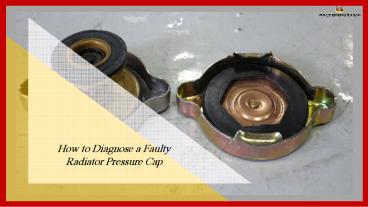How to Diagnose a Faulty Radiator Pressure Cap - PowerPoint PPT Presentation
Title:
How to Diagnose a Faulty Radiator Pressure Cap
Description:
The main function of the radiator cap is to store the coolant and the right amount of pressure in the radiator. Therefore, it should work well and any sign of coolant leaks, overflowing reservoir, air in the cooling system or engine overheating must be attained and fixed. In order to know the right ways to diagnose a faulty radiator pressure cap, go through the below s. – PowerPoint PPT presentation
Number of Views:108
Title: How to Diagnose a Faulty Radiator Pressure Cap
1
How to Diagnose a Faulty Radiator Pressure Cap
2
The radiator pressure cap contains two valves and
its purpose is to store coolant and ensure that
the radiator system remains pressurized.
3
The interior of the radiator needs to be
maintained at a fixed pressure, which is
controlled by the radiator cap.
4
And if the pressure is not constant, then the car
might overheat and the radiator might endure
severe damage.
5
Here are a few signs that will let you know if
you have a faulty radiator cap.
6
Coolant leaks
7
When the radiator cap is stuck, fluid cannot get
released and this will cause pressure to build
inside the radiator, causing the hose to leak or
break open.
8
If you notice coolant fluid near the radiator
cap, then you clearly have leaky coolant and
check the radiator for holes in it and if the cap
looks worn or damaged.
9
Overflowing reservoir
10
Coolant goes into the reservoir tank as it
expands while the radiator cap is released by the
pressure and the coolant is sent to the overflow
tank.
11
If you have a bad radiator cap, then the coolant
will get released too quickly and cause the
reservoir to boil over.
12
Collapsed radiator hose
13
A common symptom of a bad radiator cap is when
the radiator hose collapses and inspect the cap
to see if there is any damage.
14
The vacuum wont be released by the radiator cap
properly and it will cause the radiator hose to
collapse during the cooling down period.
15
Air in cooling system
16
Leaky coolant, or air in the cooling system can
lead to an overheated engine, so when the engine
gets too hot, dont look under the hood unless
youve turned the engine off.
17
That way, the engine can remain cool as you check
it out and If there is coolant fluid near the
radiator cap, there could be damage to the
pressure cap.
18
Overheated engine
19
Leaky coolant, or air in the cooling system can
lead to an overheated engine, so when the engine
gets too hot, dont look under the hood unless
youve turned the engine off.
20
That way, the engine can remain cool as you check
it out and If there is coolant fluid near the
radiator cap, there could be damage to the
pressure cap.
21
So, what to do?
22
Always check the radiator cap as it is an
important part of the radiator and cooling system
for keeping your car in good working condition.
23
Also make sure that the coolant is topped up as
if it remains consistently low level, then it can
result in the damage to the radiator as well as
the cooling system of the car.
24
https//automotive-imports.com/
https//www.facebook.com/automotiveimports/ https
//plus.google.com/Automotive-imports?hlenglus































